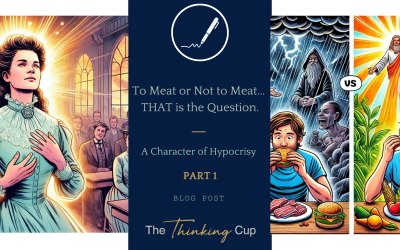There are numerous misconceptions, faulty assumptions, and flawed interpretations of Scripture within Adventism’s Theological Framework. One of these faulty assumptions can be seen in the following statement:
1 John 3:4 (KJV) indicates that sin is defined as breaking God’s Law. The Ten Commandments are the sole standard by which sin is identified. If the Ten Commandments were no longer valid, sin would cease to exist. However, since sin still exists, it confirms that the Ten Commandments continue to serve as the measure of sin.
In Adventist theology, sin is inherently tied to the existence of the Ten Commandments. Adventists view the Ten Commandments as the sole framework for defining sin, believing that without these commandments, the concept of sin would lose its meaning. To them, the abolition or absence of the Ten Commandments would render sin non-existent because sin, by their understanding, is simply a violation of this specific and eternally binding moral code. This concept is embedded in Fundamental Belief #19 – The Law of God:
“The great principles of God’s law are embodied in the Ten Commandments and exemplified in the life of Christ. They express God’s love, will, and purposes concerning human conduct and relationships and are binding upon all people in every age. These precepts are the basis of God’s covenant with His people and the standard in God’s judgment. Through the agency of the Holy Spirit they point out sin and awaken a sense of need for a Savior. Salvation is all of grace and not of works, and its fruit is obedience to the Commandments. This obedience develops Christians character and results in a sense of well-being. It is evidence of our love for the Lord and our concern for our fellow human beings. The obedience of faith demonstrates the power of Christ to transform lives and therefore strengthens Christian witness.” [1]
Additionally, Ellen White claimed that Satan’s original sin in heaven was breaking these very commandments or God’s Law.
“Good angels wept to hear the words of Satan, and his exulting boasts. God declared that the rebellious should remain in heaven no longer. Their high and happy state had been held upon condition of obedience to the law which God had given to govern the high order of intelligences. But no provision had been made to save those who should venture to transgress his law. Satan grew bold in his rebellion, and expressed his contempt of the Creator’s law. This Satan could not bear. He claimed that angels needed no law; but should be left free to follow their own will, which would ever guide them right; that law was a restriction of their liberty, and that to abolish law was one great object of his standing as he did. The condition of the angels he thought needed improvement. Not so the mind of God, who had made laws and exalted them equal to himself. The happiness of the angelic host consisted in their perfect obedience to law.” [2]
As noted above, this belief is primarily based on the teachings of Ellen White, particularly in her work The Great Controversy Between Christ and Satan, which she writes in Chapter 29 of “The Origin of Evil.” [3] This faulty Adventist understanding is also due to their interpretation of 1 John 3:4 in the King James Version (KJV), which reads as follows:
“Whosoever committeth sin transgresseth also the law: for sin is the transgression of the law.” (1 John 3:4, KJV)
However, this view rests on misinterpreting both the passage and the concept of sin. The translation of 1 John 3:4 in the KJV is not accurate. In Greek, the verse actually reads:
“πας ο ποιων την αμαρτιαν και την ανομιαν ποιει και η αμαρτια εστι(ν) και η ανομια” (1 John 3:4, Sinaiticus LXX/NT)
A more literal and ‘word for word’ translation would be something like what is found in The Lexham English Bible:
“Everyone who practices sin also practices lawlessness, and sin is lawlessness.” (1 John 3:4, LEB)
Here, the Greek word for “sin,” hamartia (ἁμαρτία), could take on several different meanings. Touted as one of the best Greek-English Lexicons, A Greek-English Lexicon of the New Testament and Other Early Christian Literature (known as BDAG) gives three different meanings for the Greek word hamartia (ἁμαρτία):
① A departure from either human or divine standards of uprightness
② A state of being sinful, sinfulness
③ A destructive evil power, sin [4]
Greek words are no different than English because the same word can have several meanings. A good example is the English word ‘RUN’. One might be surprised to learn that there are over 600 different meanings when you include all of its forms. This makes it one of the words with the most definitions in the Oxford English Dictionary. Anyone who speaks English will understand that when the word ‘run’ is used in a sentence, a person can’t just pick any definition they want and then claim they understand it. Let me explain further.
If I said, “He runs every morning,” and you choose to understand the word ‘runs’ using the definition ‘to flow in a continuous current,’ then the sentence wouldn’t make any sense. Does he turn into water and flow through the water pipes in the house? I know it seems silly, but I can’t just pick the definition that suits me and then think I am correctly interpreting the message. But since you are fluid in English, you knew immediately that when I said, “He runs every morning,” I was talking about a guy going outside and putting his running shoes on to go for a run.
This example might seem a little silly, but the lesson is the same with Greek words. I mention that the word for “sin,” hamartia (ἁμαρτία), has three different possible definitions. It’s important that we land on the correct one. The one that the author intended to be used so that our understanding of the message isn’t skewed.
After consulting with several different lexicons, it seems clear that John’s use of the word hamartia (ἁμαρτία) in 1 John literally means to “depart from the divine standard of uprightness” or “missing the mark.” (#1 in the list of BDAG definitions)
When we look at the same lexicon for the term “lawlessness (KJV), transgression of the law,” anomia (ἀνομία), we get two different definitions:
① State or condition of being disposed to what is lawless, lawlessness, opposed to, opposite.
② The product of a lawless disposition, a lawless deed[5]
We must apply the same principle of word definitions as we previously discussed. It seems clear that John is referring to a condition of being opposed to the law (#1 on the above list), which encompasses wickedness, unrighteousness, and moral disorder. This understanding goes beyond simply violating the Ten Commandments, suggesting that sin involves a broader failure to align with God’s will and moral purity. It would be a great mishandling of the text to infer that John was only referring to certain types of sins that are outlined in the Ten Commandments.
In the biblical context, sin is not confined to the boundaries of the Ten Commandments. Throughout Scripture, sin is often defined by its context and is depicted as a deviation from God’s character, a failure to reflect His righteousness and purity. The concepts of “sin” and “lawlessness” in 1 John 3:4 must be interpreted within the larger narrative of the passage. It is unnecessary or appropriate to approach this text with a preconceived bias that ties it exclusively to the Ten Commandments. Nor should we impose Exodus 20:1-17—the chapter detailing the Ten Commandments—onto this passage, as that would be a stretch far removed from the actual context of John’s writing.
John’s message in this passage is that sin is incompatible with being born of God.
“No one born of God makes a practice of sinning, for God’s seed abides in him; and he cannot keep on sinning, because he has been born of God.” (1 John 3:9, ESV)
Earlier, in verses 1-3, John emphasizes the transformative nature of being born of God, which leads to a purification of one’s character. He explains that those born of God strive toward this purification, reflecting God’s purity. By contrast, sin, which reflects a lack of self-purification, is incompatible with this spiritual transformation. In this sense, God Himself is the standard of moral purity, the “law” that believers should aim for. Those who continue to live in sin—who continually miss the mark of purity—are practicing lawlessness.
They are failing to align with the ultimate standard of God’s character, which goes beyond the Ten Commandments and encompasses the fullness of His righteousness.
John reinforces this idea later in verse 7, contrasting lawlessness and unrighteousness with righteousness. He writes,
“Little children, let no one deceive you. Whoever practices righteousness is righteous, as he is righteous.” (1 John 3:7, ESV)
Here again, the standard is God’s character—His righteousness. The one who practices sin, or lawlessness, is missing this standard of righteousness, failing to reflect the purity that comes from being born of God. This person, John argues, demonstrates by their actions that they have not truly been born of God, nor have they fully embraced the redemptive work of Jesus, who came to take away their sins (verses 5-6).
John concludes this line of reasoning in 1 John 5:17-18, where he states,
“All wrongdoing is sin, but there is sin that does not lead to death. We know that everyone who has been born of God does not keep on sinning, but he who was born of God protects him, and the evil one does not touch him.” (1 John 5:17–18, ESV)
This reinforces that sin and wrongdoing (unrighteousness) are about more than just violating the Ten Commandments. John’s point is clear: sin is the failure to reflect God’s character and righteousness, and those who have been truly born of God will not continue in this pattern of sin.
Furthermore, it’s crucial to note that John never uses the Greek word nomos (νόμος), which typically refers to the Law (including the Ten Commandments), in this entire epistle. When John speaks of “commandments,” he uses the Greek word entole (ἐντολή), which refers to Christ’s teachings, particularly the command to believe in Jesus and to love one another (as seen in 1 John 3:22-24). (Want to read more on this concept? Check out my last article.) This demonstrates that John is not referring to the Ten Commandments when discussing sin and righteousness but to a broader, more holistic standard that centers on faith in Christ (Christ’s faithfulness) and love for others.
Exegetically, the text does not support the Adventist interpretation of 1 John 3:4, which claims that the Ten Commandments are the exclusive definer of sin. John’s focus is not on the legalistic observance of the Ten Commandments but on a deeper, more relational understanding of sin, righteousness, and lawlessness. According to John, sin is a failure to embody the character of God, and righteousness is aligning oneself with God’s standard, defined by purity, love, and faith in Christ, rather than merely adherence to a specific legal code. Pledging your allegiance to the Son of God, who is the perfect sacrifice for our sins and is the reigning King above ALL Kings, is the only way to be seen by God as pure and holy, this side of our glorified bodies!
There are many different definitions of sin in the New Testament
The New Testament presents a diverse range of words that define sin, unrighteousness, lawlessness, and ungodly behavior, offering a much broader scope than just the Ten Commandments. These terms include:
-
- κακός (kakos), meading “bad” (Romans 13:3)
- πονηρός (poneros), meaning “evil or bad” (Matthew 5:45)
- ἀσέβειας (asebeias), meaning “ungodliness” (Romans 1:18)
- ἔνοχος (enochos), meaning”liable or guilt” (Matthew 5:21)
- ἁμαρτία (hamartia), meaning “lawlessness, missing the mark, sin” (1 John 3:4)
- ἁμάρτημα (hamartema), which is related to ‘hamartia’ and also means “missing the mark, sin” (1 Corinthians 6:18)
- ἄδικια (adikos), meaning “unrighteousness or injustice” (1 Corinthians 6:9)
- ἄνομος (anomos), meaning “without law, lawlessness, unrestrained” (1 Timothy 1:9)
- παραβάσις (parabasis), meaning “to sidestep or transgress” (Romans 4:15)
- ἀγνοεῖν (agnoein), meaning “to be ignorant, to sin unknowingly” (Romans 1:13)
- πλανω (planos), meaning “to go astray or wander” (2 Corinthians 6:9)
- παραπτώμα (paraptoma), meaning “to fall away” (Galatians 6:1)
- υποκρίσις (hypokrisis), meaning “hypocrisy” (Galatians 2:13; 1 Timothy 4:2).
While some of these behaviors align with the Ten Commandments, they are not limited to or defined exclusively by them. The New Testament provides many different perspectives on sin and moral wrongdoing, demonstrating that sin cannot be confined to the restrictions of the Ten Commandments or any single legal code.
Let me show you an example of what I mean. In Romans 14:23, Paul offers a unique definition of sin after discussing matters of food and religious observance, saying:
“But whoever has doubts is condemned if he eats, because the eating is not from faith. For whatever does not proceed from faith is sin.” (Romans 14:23, ESV)
This presents a profound understanding of sin, as Paul asserts that anything not born from faith is sin. This is significant because Paul also states in Galatians 3:12 that “…the law is not of faith….” In other words, the Old Covenant law, including the Ten Commandments, does not operate on the principle of faith but on works—obedience to the law. Paul clarifies this when he says,
“The one who does them shall live by them.” (Galatians 3:12, ESV)
These passages teach that there are sins defined by the law and others defined by faith. One can sin by breaking the law, but one can also sin by violating faith. The Ten Commandments have never been, and will never be, the ONLY standard for defining sin.
James 4:17 introduces another definition of sin:
“So whoever knows the right thing to do and fails to do it, for him it is sin.” (James 4:17, ESV)
This definition makes sin subjective, meaning it depends on personal knowledge and awareness. What may be sinful for one person might not be for another. This subjectivity shows that sin can exist in areas that are unrelated to the Ten Commandments or any other codified laws. If the Holy Spirit convicts someone of a specific action or behavior, and they ignore that conviction, it becomes a sin for them. This shows that life, relationships, and cultural norms are too complex for the Ten Commandments to serve as THE sole and all-encompassing definer of sin. The Ten Commandments are inadequate in addressing many modern issues, such as real estate disputes, cybercrime, healthcare, road safety, environmental concerns, scientific research, racial and social justice, and more. Sins and moral violations can still occur in these areas despite not speaking directly to these issues.
John adds another layer to this understanding in 1 John 5:16-17, where he writes:
“If anyone sees his brother committing a sin not leading to death, he shall ask, and God will give him life—to those who commit sins that do not lead to death. There is sin that leads to death; I do not say that one should pray for that. All wrongdoing is sin, but there is sin that does not lead to death.” (1 John 5:16–17, ESV)
Here, John distinguishes between sins that lead to death and those that do not, contradicting the Adventist view that the Ten Commandments define all sin. If this passage were solely about the Ten Commandments, it would not make sense, as all sins under the Ten Commandments were considered worthy of death under the Old Covenant.
Paul’s teachings in Romans 2:12-16 further dismantle the idea that sin is confined to the Ten Commandments. He writes:
“For all who have sinned without the law will also perish without the law, and all who have sinned under the law will be judged by the law. For it is not the hearers of the law who are righteous before God, but the doers of the law who will be justified. For when Gentiles, who do not have the law, by nature do what the law requires, they are a law to themselves, even though they do not have the law. They show that the work of the law is written on their hearts, while their conscience also bears witness, and their conflicting thoughts accuse or even excuse them on that day when, according to my gospel, God judges the secrets of men by Christ Jesus.” (Romans 2:12–16, ESV)
Paul is clear in verse 12 that sin can exist both outside the law and under the law. This statement would create a major theological issue if the Ten Commandments were the only standard for sin. Additionally, Paul points out that Gentiles, who did not have the Jewish law, still followed moral principles by nature. These innate moral principles were written on their hearts and governed by their conscience. This shows that Gentiles were aware of sin even without the written law or the Ten Commandments, proving that moral understanding and sin can exist outside these laws.
Finally, Paul asserts in Romans 5:12-13,
“Therefore, just as sin came into the world through one man, and death through sin, and so death spread to all men because all sinned— for sin indeed was in the world before the law was given, but sin is not counted where there is no law.” (Romans 5:12–13, ESV)
This demonstrates that sin existed before the law was introduced at Mount Sinai. The existence of sin outside of the Ten Commandments makes it clear that these laws are not and never will be the sole standard by which sin is defined. The Adventist interpretation of 1 John 3:4 is both contextually and theologically flawed. Sin, as presented in the New Testament, is a far more complex and multifaceted concept than the Adventist view allows.
In Christian Love,

[1] “Seventh-Day Adventists Believe, pg. 358”
[2] Ellen Gould White, The Signs of the Times, n.d., 212.
[3] Ellen Gould White, The Great Controversy Between Christ and Satan, vol. 5, Conflict of the Ages Series (Pacific Press Publishing Association, 1911), 492.
[4] William Arndt et al., A Greek-English Lexicon of the New Testament and Other Early Christian Literature (Chicago: University of Chicago Press, 2000), 50-51.
[5] William Arndt et al., A Greek-English Lexicon of the New Testament and Other Early Christian Literature (Chicago: University of Chicago Press, 2000), 85.




0 Comments